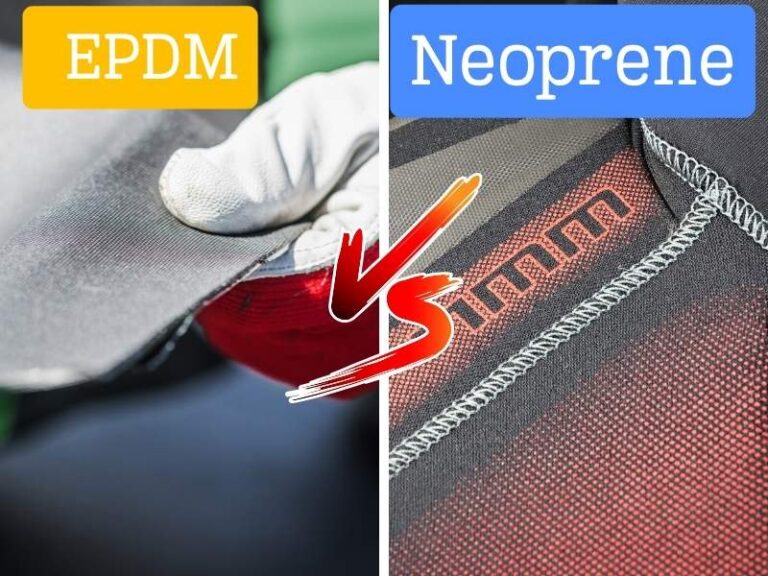What’s Better Than Neoprene?
Neoprene, a synthetic rubber material, has long been favored for its versatility and durability. However, various high-performance alternatives outshine neoprene in specific applications. The popularity of neoprene can be attributed to its widespread use in numerous industries, such as automotive, construction, and sportswear.
When it comes to high-performance materials, it’s crucial to consider the specific needs of your project or application. For instance, polyurethane foam offers exceptional cushioning and impact resistance, making it perfect for protective gear and athletic equipment. On the other hand, Gore-Tex fabric provides excellent breathability and waterproofing properties, ideal for outdoor clothing and footwear.
Carbon fiber composites have gained popularity due to their incredible strength-to-weight ratio, making them a preferred choice for aerospace and automotive industries. Aramid fibers, known for their high heat resistance and tensile strength, are widely used in protective gear and military applications.
These superior alternatives offer enhanced performance in specialized applications, providing a wider range of options for industries seeking the highest standards of quality and performance.
Innovations In Material Science
Innovations in Material Science – Evolution from neoprene to advanced materials:
Material science plays a crucial role in developing innovative solutions for various industries. It constantly strives to improve existing materials and discover new ones that surpass their predecessors in terms of performance and functionality.
Neoprene, a synthetic rubber, has been widely used due to its excellent resistance to water, oils, heat, and chemicals. However, advancements in material science have given rise to even better alternatives that cater to specific requirements.
Polyurethane (PU), for instance, offers superior durability and elasticity, making it a perfect choice for industries such as sportswear and automotive. It provides enhanced comfort and flexibility, essential for high-intensity activities.
Gore-Tex, a waterproof and breathable fabric, revolutionized outdoor gear by offering exceptional performance in extreme conditions. It became the go-to material for outdoor enthusiasts due to its ability to keep water out while allowing sweat to escape.
In recent years, graphene-based materials have shown immense potential in various applications. Known for their exceptional strength, conductivity, and flexibility, they have attracted attention in fields ranging from electronics to energy storage.
As technology continues to advance, material scientists will undoubtedly unveil more remarkable alternatives, ensuring the evolution of materials never ceases.
Advanced Textiles For Athletes
Athletes need fabrics that can keep up with their high-intensity workouts and rigorous training schedules. While neoprene has long been a popular choice for athletes, there are even better alternatives available today.
One key feature to look for in advanced textiles is breathability. These fabrics allow air to flow through, keeping athletes cool and comfortable during their workouts. Additionally, they have moisture-wicking properties that draw sweat away from the skin, preventing the build-up of moisture and reducing the risk of chafing and discomfort.
Another advantage of advanced textiles is their compression and recovery benefits. Compression fabrics provide support to muscles and joints, reducing muscle fatigue and soreness. They also enhance blood circulation, helping to deliver oxygen and nutrients to the muscles and aiding in faster recovery after workouts.
Environment-friendly Rubber
Discover the superior alternative to neoprene with environment-friendly rubber. This sustainable material offers the same durability and performance with a reduced carbon footprint. Improve your environmental impact without compromising on quality.
| Environment-Friendly Rubber |
recyclablesustainable alternatives to neoprene. With concerns about the environmental impact of synthetic materials, many industries are now turning to innovative solutions that prioritize sustainability. Natural rubber, derived from the sap of rubber trees, offers a more eco-friendly option. It boasts impressive properties that make it a suitable replacement for neoprene in various applications. Natural rubber is highly durable, flexible, and resistant to extreme temperatures, making it ideal for products like wetsuits, gloves, and sporting equipment. Additionally, advancements in natural rubber production have enabled manufacturers to improve its performance and reduce its environmental footprint. By embracing natural rubber and its sustainable properties, we can move towards a greener and more eco-conscious future.
Cutting-edge Polymer Blends
Discover cutting-edge polymer blends that outperform neoprene. These innovative materials offer superior strength, flexibility, and durability, making them the ideal choice for a wide range of applications. Explored here are the qualities and advantages of these advanced polymer blends over neoprene.
| What’s Better Than Neoprene? |
| Cutting-Edge Polymer Blends |
| Enhanced durability and flexibility The latest advancements in polymer blends have revolutionized the industry, offering enhanced durability and flexibility that surpasses neoprene. These cutting-edge blends are designed to withstand extreme conditions and provide long-lasting performance. With their superior strength and resilience, they are perfect for applications that require high durability and flexibility, such as protective gear, industrial equipment, and sporting goods. Moreover, these polymer blends offer exceptional resistance to extreme temperatures, making them suitable for use in both hot and cold environments. Whether it’s facing scorching heat or freezing cold, these blends can maintain their integrity and functionality, ensuring the utmost performance and reliability. |
Aerospace Inspired Composites
Aerospace inspired composites are revolutionizing the world of extreme sports gear. These lightweight yet strong materials are proving to be better than neoprene in terms of performance and durability. With their advanced technology and innovative design, aerospace composites offer numerous advantages for athletes and adventurers seeking the best gear for their extreme pursuits.
The applications of aerospace composites in extreme sports gear are vast. These materials are being used to create high-performance wetsuits, harnesses, helmets, and protective gear. Their exceptional strength-to-weight ratio allows athletes to move freely while staying protected. Whether it’s surfing, snowboarding, rock climbing, or skydiving, aerospace composites provide the necessary strength and flexibility to withstand the harsh conditions of these extreme sports.
One of the key benefits of aerospace composites is their ability to resist impact and abrasion. This makes them ideal for extreme sports where athletes often encounter rough terrains and unpredictable elements. Additionally, the lightweight nature of these materials ensures athletes can perform at their best without feeling weighed down.
Smart Fabrics And Nanomaterials
Smart fabrics and nanomaterials offer a superior alternative to neoprene, providing enhanced functionality and performance for various applications. With innovative technology and advanced properties, these materials revolutionize the way we think about textiles, offering improved comfort, breathability, durability, and versatility.
Experience the next level in fabric innovation with smart fabrics and nanomaterials.
Integration Of Technology With Textiles
The integration of technology with textiles has revolutionized the world of fabrics. Smart fabrics and nanomaterials have emerged as game-changers, offering advanced features that make them better than traditional options like neoprene.
Self-healing and Shape-memory Features
One remarkable feature of smart fabrics is their self-healing capability. These fabrics have the ability to repair small damages on their own, increasing their lifespan and durability. Moreover, they also possess shape-memory properties, allowing them to revert to their original form after being stretched or deformed. This makes them perfect for applications where repeated stretching or bending occurs.
By incorporating nanomaterials into fabrics, a whole new level of functionality is introduced.
Nanoparticles can impart various unique properties to the fabric, such as stain resistance, water repellency, and UV protection. These features not only enhance the practicality of the fabric but also add value for the users.
The integration of technology with textiles has opened up a world of possibilities. With smart fabrics and nanomaterials, the future of textiles looks promising, offering superior performance and enhanced functionalities.
Physical Properties Comparison
Neoprene is a versatile synthetic rubber renowned for its exceptional properties. However, there exists an alternative material that surpasses neoprene in various aspects. When comparing physical properties, such as tensile strength and elasticity, the alternative material demonstrates superior performance.
Unlike neoprene, the alternative material exhibits remarkable strength under tension, allowing it to withstand greater forces without tearing or deforming. Additionally, its exceptional elasticity enables it to stretch and recover efficiently, retaining its shape and form for longer periods.
When considering thermal and chemical resistance, the alternative material excels once again. It offers greater resistance to high temperatures and chemical substances, ensuring longevity and durability even in challenging environments.
The outstanding physical properties and resistance of the alternative material make it the preferred choice for various applications. From industrial uses to consumer goods, this material outperforms neoprene in crucial aspects.
Environmental Impact And Sustainability
When considering the environmental impact and sustainability of neoprene, two key factors come to mind: carbon footprint and recyclability.
Carbon Footprint: Neoprene production is known for its high carbon footprint, mainly due to the energy-intensive manufacturing process and the use of petroleum-based resources. However, there are alternatives available that aim for a lower carbon footprint, such as plant-based neoprene made from renewable sources like limestone and sugar cane.
Recyclability: Traditional neoprene is not easily recyclable, which poses a significant challenge from a sustainability perspective. However, innovations in neoprene recycling technology are emerging, enabling the creation of recycled neoprene materials with a reduced environmental impact.
In addition to reducing the carbon footprint and increasing recyclability, it’s crucial to consider the sourcing of neoprene. Ethical sourcing practices ensure that the materials used are produced under fair labor conditions and without exploiting the environment.
Versatility And Adaptability
Neoprene has long been known for its versatility and adaptability, making it a popular choice for a variety of applications. With its range of applications and customizations, neoprene offers sector-specific material benefits that make it stand out from other materials. Its resistance to heat, chemicals, and UV rays make it ideal for use in industries such as automotive, aerospace, and electronics. Neoprene’s insulating properties and durability also make it a valuable material for outdoor gear, wetsuits, and protective clothing. Moreover, its flexibility allows for easy fabrication and customization, enabling manufacturers to create products that meet specific requirements. Whether it’s providing insulation, protection, or comfort, neoprene proves to be a reliable choice for various industries and applications. So, when it comes to versatility and adaptability, there’s simply nothing better than neoprene.
From Wetsuits To Wearables
Leading brands continue to push the boundaries of water sports apparel, constantly seeking improved materials and technologies that offer enhanced performance and comfort. Neoprene, once the go-to material for wetsuits, is being surpassed by new innovations.
One such innovation is the development of eco-friendly alternatives to neoprene, such as natural rubber and bio-based synthetics. These materials not only provide the necessary insulation and flexibility but also reduce the environmental impact associated with neoprene production.
Moreover, advancements in fabric engineering have resulted in garments that are lighter, more breathable, and quick-drying. Brands are incorporating moisture-wicking fabrics and ventilation systems to optimize the wearer’s comfort and performance.
Additionally, the integration of smart technology into water sports apparel has revolutionized the industry. Wearable devices can now monitor heart rate, track distance, and provide real-time feedback, enhancing the overall experience for water sports enthusiasts.
Success stories from leading brands showcase the positive impact of these innovations. Performance-driven athletes and casual water sports enthusiasts alike can benefit from the constant evolution of water sports apparel, ensuring an incomparable experience in the water.
Automotive And Industrial Breakthroughs
High-performance materials in vehicles have paved the way for significant advancements in efficiency and durability. Enter neoprene, a versatile synthetic rubber that offers exceptional resistance to chemicals, oils, and extreme temperatures. Neoprene’s widespread use in automotive manufacturing can be attributed to its ability to reduce vibrations and noise, enhancing the overall driving experience.
But what if there’s something even better than neoprene? Automotive and industrial industries are constantly on the lookout for materials that go above and beyond. Enter innovative alternatives like thermoplastic elastomers (TPEs) and reinforced rubber composites. These materials offer enhanced strength, flexibility, and resistance to wear and tear, making them ideal for automotive applications. They also provide improved fuel efficiency and reduced weight, leading to a greener and more sustainable future.
In addition to materials, efficiency improvements in manufacturing processes have revolutionized the automotive and industrial sectors. Advanced techniques like additive manufacturing (3D printing) have enabled faster prototyping and reduced lead times, resulting in cost savings and increased productivity. Furthermore, automation and robotics have streamlined production lines, ensuring precision and consistency while reducing labor costs.
Sports And Medical Gear Transformations
Sports and Medical Gear Transformations
Enhancements in protective equipment
Breakthroughs in medical device materials
The advancement in technology has not only revolutionized our daily lives but also significantly impacted the sports and medical industries. The quest for better performance and safety has led to remarkable transformations in sports and medical gear. Protective equipment has witnessed significant enhancements, offering athletes and medical professionals increased safety and functionality.
In the sports arena, the demand for innovative materials has given rise to alternatives to neoprene, which is commonly used in gear such as wetsuits and knee braces. Cutting-edge materials like compression fabrics with moisture-wicking properties that enhance flexibility and provide targeted support are gaining popularity. Such advancements in protective equipment assure athletes of enhanced performance and reduced risk of injuries.
Similarly, the medical field has seen breakthroughs in device materials that have greatly improved patient outcomes. From surgical implants to prosthetics, advanced materials like titanium alloys, biocompatible polymers, and ceramics have replaced traditional options. These materials offer superior durability, compatibility, and functionality, resulting in better treatment options and faster recovery times for patients.
These advancements not only benefit athletes and patients but also have a positive impact on the overall development of the sports and medical industries. The continuous pursuit of better materials and equipment ensures that the standards of performance and care are constantly elevated, improving the lives of individuals worldwide.
Balancing Cost And Performance
Premium materials vs. cost-effectiveness
Consumer trends in material selection
The selection of materials is a crucial aspect when it comes to finding the perfect balance between cost and performance. Today’s consumers are becoming increasingly aware of the options available to them and are looking for materials that offer both quality and affordability. Premium materials, such as neoprene, undoubtedly provide excellent performance, offering durability, flexibility, and resistance to various elements.
However, they often come at a higher price point. On the other hand, cost-effective alternatives can provide a compelling choice, especially when consumer trends indicate a preference for sustainable and eco-friendly materials. These alternatives offer decent performance while being more budget-friendly, making them a popular choice for those seeking an optimal balance between cost and performance.
Whether opting for neoprene or exploring other materials, understanding consumer preferences is vital in catering to their needs and maintaining a competitive edge in today’s market.
Future Of Performance Materials
The world of performance materials is constantly evolving and pushing the boundaries of what is possible. As we look ahead, several emerging materials show great promise and could revolutionize various industries. Research and development efforts are focused on exploring these materials and their potential applications.
One such material gaining traction is graphene. Its exceptional strength, conductivity, and flexibility have sparked interest in electronics, energy storage, and even aerospace industries. Another emerging material is shape-memory alloys, which have the ability to “remember” their original shape and can be deformed and then return to their original form when triggered by temperature or other external stimuli.
| Material | Potential Applications |
|---|---|
| Carbon nanotubes | Electronics, aerospace, and energy storage |
| Bioplastics | Packaging, agriculture, and automotive industry |
| Smart textiles | Sports, healthcare, and fashion industry |
In addition, there is ongoing research in the field of self-healing materials, which have the ability to repair damage autonomously. These materials could have significant implications in the automotive, construction, and medical industries, reducing maintenance and repair costs.
The future of performance materials looks promising, with advancements on the horizon that could unlock endless possibilities and reshape various sectors. The combination of these emerging materials with innovative manufacturing techniques has the potential to push the boundaries of performance and revolutionize industries worldwide.
Frequently Asked Questions For What’s Better Than Neoprene?
Is Neoprene The Best Material For Insulation?
Neoprene is a great insulating material, but there are alternatives that perform even better. Aerogel insulation, for example, offers superior thermal resistance while being lightweight and environmentally friendly.
What Makes Neoprene A Popular Choice In Various Industries?
Neoprene’s versatility and durability make it ideal for various industries. Its resistance to temperature, chemicals, and weathering makes it a top choice for wetsuits, automotive parts, and electrical insulation.
Are There Any Downsides To Using Neoprene?
While neoprene is a reliable material, it has a few drawbacks. It can be heavy and less breathable compared to other materials. Additionally, it may also be more expensive than alternative options. Evaluating your specific needs can help determine if neoprene is the best fit for your project.
Conclusion
When it comes to finding a material that surpasses neoprene, look no further. With its exceptional qualities and versatility, it is clear that there is nothing better. From enhanced flexibility to superior insulation and durability, neoprene stands as the ultimate choice for various applications.
So why settle for anything less? Embrace the countless benefits of neoprene today and experience a world of excellence.
- Can I Get in a Taxi Without a Car Seat? - January 26, 2025
- Can I Get Chlamydia From a Toilet Seat? - January 26, 2025
- Can I Get an Uber With a Car Seat? - January 26, 2025






